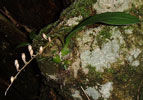|
|
|
|
|
| |
Flasks of
Liparis plicata 'MC536' -spontaneous |
|
| |
|
|
| |
| Number: |
TN1644 |
| Name: |
Liparis plicata 'MC536' -spontaneous
|
| Type: |
spontaneous (What's that?) |
|
Seed Donor: |
Leung Hung Eve
|
|
Click to Enlarge

Pod Parent Plant with Capsules |
|
|
|
| |
Culture Notes from Donor:
Temperature: Summer 24c to 28c, night 20c to 24c; winter 5c to 10c
Humidity: Summer 90% up; Winter 60% to 80%
Growing condition: attached on the rocks near the water steam, heavy shade and high humidity throughout the year
Comments: Small-sized lithophyte
For additional origin/habitat information supplied courtesy of
Charles and Margaret Baker, see further below, near the bottom of this page.
|
Temperatures we attempt to use in the lab & greenhouse:
| For Species: |
|
Spring, Summer, Autumn, Winter: days average 76°F, nights 64°F; best fit is Cool-Intermediate 75-58°F
(Source:
Baker's Web OSC) |
|
About the name...
| Etymology of |
Liparis |
|
From Greek "liparos" greasy, shining; referring to the shiny leaves.
(Source:
Mayr & Schmucker 1998) |
| Etymology of |
plicata |
|
From Latin "plicatus" folded.
(Source:
Mayr & Schmucker 1998) |
| Pronunciation of |
Liparis |
|
li-PAH-ris
(Source:
Hawkes 1978) |
| Pronunciation of |
plicata |
|
ply-KAH-ta
(Source:
Hawkes 1978) |
|
If you would like to direct someone to this web page, please copy and paste this URL into your email:
http://troymeyers.com/d?011644
| Flask Information |
| Availability: |
There were problems with this item and we weren't able to make any viable flasks. |
| You should: |
Consider placing a "Notify Retries" Request, and if an identical pollination (the same parents) is done again, we'll let you know. |
|
You might also want to:
|
View the seed assay for this item.
View items of the same species.
View items of the same genus.
|
|
|
| |
The origin/habitat information below is supplied courtesy of Charles and Margaret Baker
The following information is based on the name of the plant provided by the donor, and assumes that the name is correct. If the plant has been misidentified, then the following information may not be correct.
This text is copyrighted by the Bakers and may not be reproduced without permission.
ORIGIN/HABITAT: Widespread from Nepal and the eastern Himalaya region
through Southeast Asia, Malaya, and China, with distribution extending to
Hainan Island, Taiwan, the Philippines, the Ryukyu Island and Japan.
Plants have also been reported from Borneo and Java. In the Himalaya
region, plants have been reported from several areas in Bhutan, in
Darjeeling, in Sikkim, and the Khasia Hills at 4250-6900 ft, (1300-2100
m). In China, plants have been found in the provinces of Jiangxi, Fujan,
Guangdong, Guangxi, Sichuan, Guizhou, Yunnan, and Xizang where plants grow
on trees and rocks in forests, on the edge of forests, or along valleys at
2600-7550 ft. (800-2300 m). These plants have been found in western
Thailand from the northwest mountains at 5000-5600 ft. (1520-1700 m)
southward to peninsular Thailand, with no habitat elevations reported in
the southern locations. In Vietnam. This lithophytic orchid is found in
the northeastern province of Cao Bang. Plants are rather common in this
area, growing in open areas in mossy primary forests of semideciduous,
mixed, and coniferous trees found on rocky, weathered limestone at
1950-4900 ft. (600-1500 m). In Malaya, this orchid has been recorded only
from Gunng Raya on Langkawi, an island just off the northwest coast near
the border with Thailand. This orchid is reported to be fairly common in
both East, where it grows south of G. Semeru at 2700 ft. (820 m) and West
Java where it is found at 3300-4100 ft. (1000-1250 m). On Borneo, plants
are know from Kalimantan and Sabah where they are found on hill and lower
montane forest at 3950-4900 ft. (1200-1500 m). This orchid is rather
widespread in the Philippines, but details of habitat location and
elevation were not given. On Taiwan, plants are said to be found in the
lowlands at up to 3950 ft. (1200 m).
Because of the wide range in distribution and habitat elevation, two
CLIMATE tables are included below. One CLIMATE table represents the
warmer, tropical portion of the habitat, while the other is for the
cooler, more temperate part of the habitat. The two CLIMATE tables give
some indication of the range of conditions to which Liparis bootanensis
should adapt.
More about this information and the Bakers...
|
|
|
| |
|
|
|